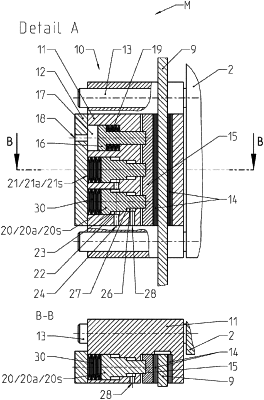| CPC B66B 5/18 (2013.01) | 20 Claims |

|
1. A car brake (10) and circuit arrangement for activating a brake function, in particular an emergency braking function of an externally powered car brake (10), which interacts with at least one guide rail (9), of a lift system (AS), the circuit arrangement and the car brake (10) being built directly on a car (2) of the lift system (AS),
the car brake (10) having, for providing the emergency braking function at least in the region of a guide rail (9), at least one lifting piston (20a) and at least two control pistons (20), on which a brake spring force (30) acts, which exerts a normal force on the guide rail (9) via at least one lining support (15) provided with a brake lining (14) and thus generates a deceleration force on the car (2) in the direction of travel (M),
the at least one lifting piston (20a) being designed to provide a first brake force, and the at least two control pistons (20) being designed to provide a second brake force, which is added to the first brake force,p
the at least two control pistons (20) and the at least one lifting piston (20a) each being mounted in a control cylinder (21) and in a lifting cylinder (21a) and being loadable with external energy such that the car brake (10) is opened counter to the brake spring force (30), and
the circuit arrangement having a pressure supply (P) or a voltage supply (U), from which a line section (L1) with a pressure reservoir (D1) or an energy storage device (SP) is supplied,
wherein, in a first step for opening the car brake (10), the line section (L1) is connected to a line section (L2) via at least one magnetic directional valve (V1, V2) or at least one switch (SC1, SC2), and at least one lifting cylinder (21a) is loaded with external energy as a result, and
that in a second step for opening the car brake (10), the at least two control cylinders (21) are additionally loaded with external energy by at least two cascade control valves (V5, V6, Vn) or at least two cascade control switches (SC3, SC4, SCn) via line sections (L3, L4, Ln); and
characterised in that, during emergency braking according to a first strategy, which requires high braking forces depending on the friction conditions between guide rail (9) and brake linings (14) and on the loading and direction of travel of the car (2),
the line section (L2) is decoupled from the external energy via the at least one magnetic directional valve (V1, V2) or the at least one switch (SC1, SC2), and thus a first braking force is generated on the guide rail (9) via the brake spring force (30) of the at least one lifting cylinder (21a),
that all the line sections (L3, L4, Ln) are decoupled from the external energy simultaneously via the cascade control valves (V5, V6, Vn) or cascade control switches (SC3, SC4, SCn), and a second braking force is generated on the guide rail (9) by all the control cylinders (21) with their brake spring force (30),
that the deceleration of the car (2) is measured continuously during emergency braking,
that, when predefined threshold values for the deceleration of the car (2) are exceeded, at least one of the control cylinders (21) is supplied with external energy via at least one of the cascade control valves (V5, V6, Vn) or at least one of the cascade control switches (SC3, SC4, SCn), and the braking force is reduced, and
that, when the deceleration of the car (2) subsequently falls below predefined threshold values, at least one of the control cylinders (21) is disconnected from the external energy via at least one of the cascade control valves (V5, V6, Vn) or at least one of the cascade control switches (SC3, SC4, SCn), and the braking force is increased.
|